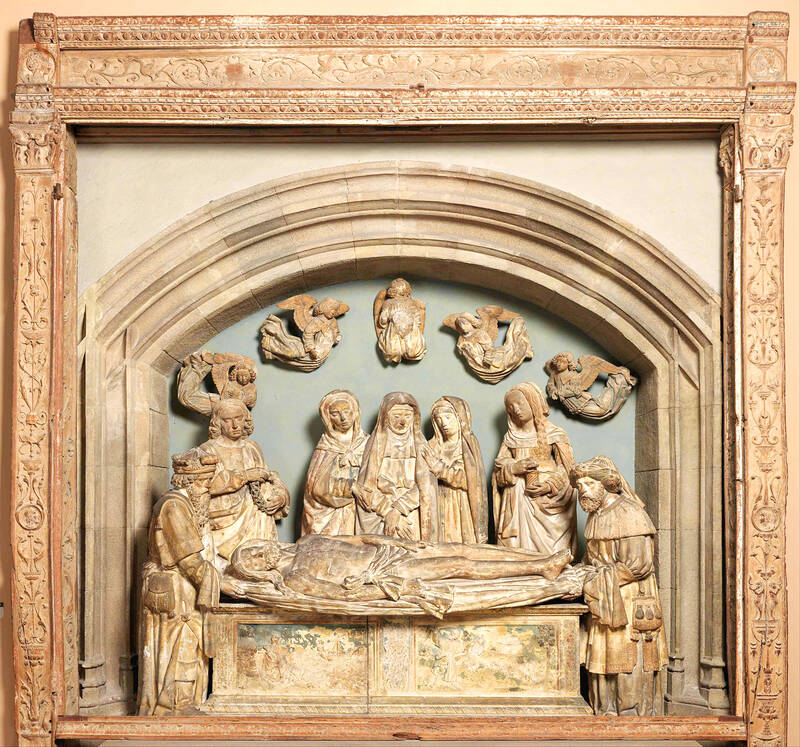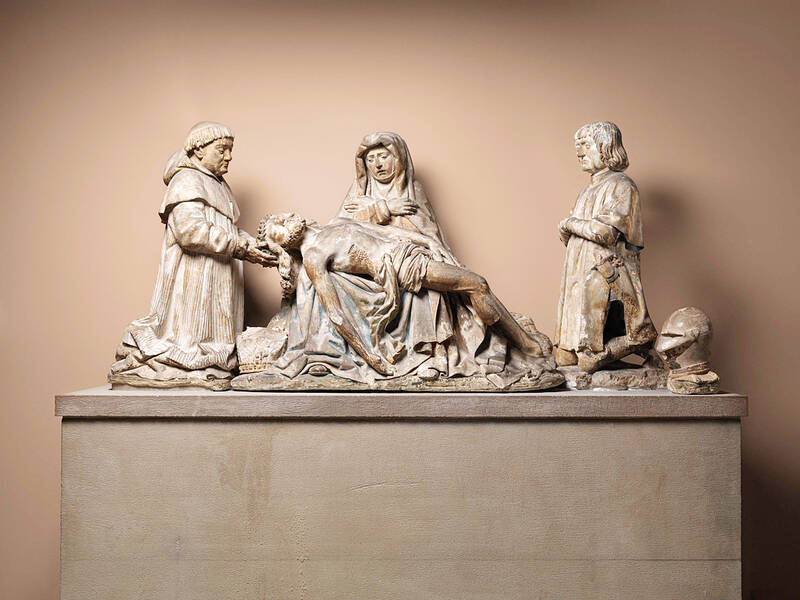Two 16th-century sculptures, jewels of French Renaissance art, have been on display since 1908 at New York’s Metropolitan Museum of Art.
But thanks to modern technology and an unusual agreement, precise 3D copies will be made and installed in the French castle where the originals long resided.
The facsimiles plan is the fruit of a rare partnership between the Met, as the New York museum is known, and the Dordogne department in southwestern France.

Photo: AFP
The statues, both from the early 1500s and by an anonymous sculptor, represent Biblical scenes entitled Entombment of Christ and Pieta With Donors. A tourism promotion agency in the Dordogne, Semitour, will be working with the Atelier of Fac-Similes Perigord (AFSP) to make the replicas over the coming months.
For nearly 400 years, the originals graced the chapel of the Biron chateau in the Dordogne. Built on a strategic promontory, the sprawling fortress comprises buildings from different eras, including a dungeon dating to the 12th century.
Damaged and rebuilt repeatedly through the centuries, the chateau has belonged since 1978 to the Dordogne department, which declared it a historic monument, Dordogne president Germinal Peiro said during a visit to the Met.

Photo: AFP
The technology to be employed in copying the sculptures was described by Francis Rigenbach, who heads the Perigord atelier, and C. Griffith Mann, the Met’s medieval art curator.
Using 3D scanners to make digital images of the sculptures, artisans will be able to create replicas without having to move or disturb the monumental originals.
“By making a digital ‘cast,’” said Rigenbach, “we can employ non-invasive techniques” to produce identical copies.
He added that “90 percent of the artistic work” will involve reproducing signs of wear, such as the patina on the aging marble originals — though both statues are considered exceptionally well-preserved.
The replicas, to be returned to their original spots in the Biron chapel, will cost around 350,000 euros (US$375,000), Rigenbach added. His atelier is famed for having copied the celebrated Lascaux cave — including its prehistoric wall art — for a museum in Montignac, northern Perigord.
That allows visitors to feel as if they were visiting the cave itself, which was closed 60 years ago to avoid damage to the fragile site, said Sebastien Cailler, who manages the Biron chateau.
“And when you see these facsimile sculptures in Biron, you’ll surely feel the same emotion as if you were standing before the originals,” he said in New York.
The two statues, whose value was recognized by historians and collectors in the late 18th century, were sold in 1907 by the last marquis of Biron to wealthy American banker John Pierpont Morgan, who was then president of the Met board.
In the 1950s, Dordogne and the Biron castle negotiated with the Met for four years in a vain effort to recover the statues. In 2018, Perigord officials revived talks with the Met; four years later, technological tests were undertaken, and then on Wednesday last week, the agreement was signed in New York.
This type of unusual deal ensures that art works can exist in two places, Mann said, while adding that his museum, with its millions of annual visitors, “seems like the safest place to have the sculptures for their long-term preservation.”

May 11 to May 18 The original Taichung Railway Station was long thought to have been completely razed. Opening on May 15, 1905, the one-story wooden structure soon outgrew its purpose and was replaced in 1917 by a grandiose, Western-style station. During construction on the third-generation station in 2017, workers discovered the service pit for the original station’s locomotive depot. A year later, a small wooden building on site was determined by historians to be the first stationmaster’s office, built around 1908. With these findings, the Taichung Railway Station Cultural Park now boasts that it has

The latest Formosa poll released at the end of last month shows confidence in President William Lai (賴清德) plunged 8.1 percent, while satisfaction with the Lai administration fared worse with a drop of 8.5 percent. Those lacking confidence in Lai jumped by 6 percent and dissatisfaction in his administration spiked up 6.7 percent. Confidence in Lai is still strong at 48.6 percent, compared to 43 percent lacking confidence — but this is his worst result overall since he took office. For the first time, dissatisfaction with his administration surpassed satisfaction, 47.3 to 47.1 percent. Though statistically a tie, for most

In February of this year the Taipei Times reported on the visit of Lienchiang County Commissioner Wang Chung-ming (王忠銘) of the Chinese Nationalist Party (KMT) and a delegation to a lantern festival in Fuzhou’s Mawei District in Fujian Province. “Today, Mawei and Matsu jointly marked the lantern festival,” Wang was quoted as saying, adding that both sides “being of one people,” is a cause for joy. Wang was passing around a common claim of officials of the People’s Republic of China (PRC) and the PRC’s allies and supporters in Taiwan — KMT and the Taiwan People’s Party — and elsewhere: Taiwan and

Six weeks before I embarked on a research mission in Kyoto, I was sitting alone at a bar counter in Melbourne. Next to me, a woman was bragging loudly to a friend: She, too, was heading to Kyoto, I quickly discerned. Except her trip was in four months. And she’d just pulled an all-nighter booking restaurant reservations. As I snooped on the conversation, I broke out in a sweat, panicking because I’d yet to secure a single table. Then I remembered: Eating well in Japan is absolutely not something to lose sleep over. It’s true that the best-known institutions book up faster